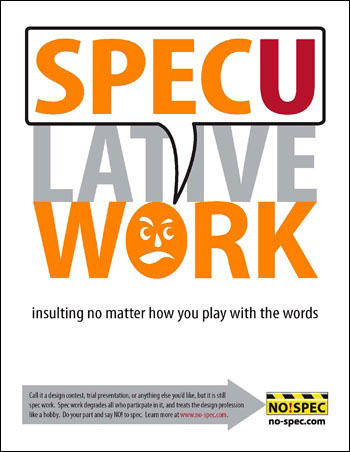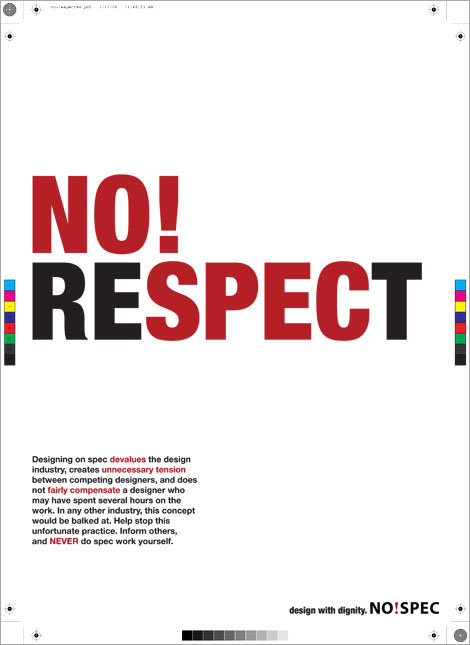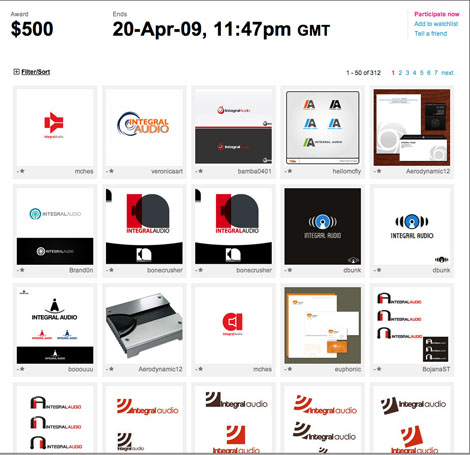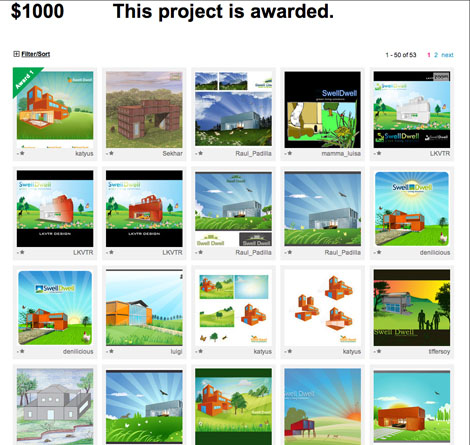Spec Work and Crowdsourcing: Gambles that Don't Pay Off

Finding meaningful work that pays well has always been a challenge for designers. You hustle to attract prospective clients, produce thorough proposals highlighting your suitability for the assignment; pitch possible design solutions; submit a bid for a budget; and hopefully get the job.
If you do, you work to develop a good relationship with the client that includes constant and thoughtful communication about objectives, goals, and branding. Based on feedback, designs evolve over time until the client is satisfied. Then you cash your well-deserved check.
But increasingly, this process is being undermined by two client initiatives, one old and one new: spec work and crowdsourcing.
Spec Work
With the economy in a freefall, more companies are pinching pennies by asking designers to work “on spec” — in other words, to produce completed creative work with no guarantee of being paid.
A typical scenario: A startup business needs a logo. The company owners have only the vaguest idea what this important identifier should look like, so they contact you to come up with some concepts. They say, “We’re exploring ideas to see what resonates. A contract isn’t necessary. We’ll pay you when we see what you come up with.” Unbeknownst to you, they’ve said the same thing to 10 other designers.
Thinking that you have the job, you produce three polished logos and give them to the client. Looks great, the client says. A few weeks drag by. Finally, the client emails you to say that the company has decided to go with a different design. You get nothing but “thanks” for your time.
Whether you’re surprised by spec or enter into it willingly, spec work is like playing roulette with your work, gambling that your time and effort will win you the gig and therefore pay off. But as with any game of chance, the odds are often against you. Instead of putting your energy into finding paying clients, you could be losing money by spending your time on speculative projects.
In response to the trend of working on spec, designers have bonded together as an organization called No!Spec. A grassroots effort, No!Spec formed three years ago after companies began soliciting work through design contests at an alarming rate. Ground central for the movement is the No!Spec Web site, which spells out what spec work is, why it needs to be avoided, and what can be done to stem the tide. These seasoned designers believe that working on spec devalues design as a profession as well as the work and skills it to takes to produce quality work. Advocates of the No!Spec movement say that working on-spec turns design into a commodity.
The posters below bring awareness to the No!Spec movement. The designers are, from top to bottom, Von Glitschka, Rob Gough, and Chad Behnke. For higher-resolution versions of these, more poster designs, and for rules of usage, see No!Spec.com.



Crowdsourcing
Another twist on working without guarantee of payment is crowdsourcing, which bypasses the paid professional in the form of an open call to anyone interested in participating. A common approach is for a company or agent to post a need on a Web site and let the world at large fill it.
The current poster child for crowdsourcing within the design community is CrowdSpring. The idea behind CrowdSpring — and its precursor, 99designs — is to attract both clients and designers with an eye toward matching them up. Clients post a design job — for example, a company in search of logo, stationery, Web site UI — on the Crowdspring site, describing what’s wanted, when it’s needed, and, most importantly, the fee. Designers respond by posting the requested work on the site. After an allotted period of time, the client chooses a “winner,” who is then paid in exchange for the work and all rights associated with it. All other entrants are out of luck.
The CrowdSpring Web site shows a grid of designs entered for each project as well as fee, deadline, and a tally of submissions. Winning designs are revealed after the contest ends, indicated by a green triangle. Click on the images to see larger versions.


Many of the designers attracted to sites like CrowdSpring are amateurs looking to break into the business. While designers have to start somewhere, the perception that anyone can be a designer without proper training and experience has ruffled some feathers. Fanning the flames was a Forbes.com article about CrowdSpring that described the company as setting out to “slash the cost of graphic design work — and democratize a snooty business.” Posts raged across the blogosphere, railing against not only CrowdSpring’s business model but also objecting to Forbes’ characterization of designers as “snooty.” CrowdSpring says that it is simply providing more opportunities for designers — and clients — in a changing econmonic and media environment.
What You Can Do
Working on spec or posting work to a site like CrowdSpring has appeal, to be sure. Designers feeling the current financial pinch might see these two strategies as a way to get work, any work. Aspiring designers may view spec/crowdsourcing as means to attract attention and build a client base. However, before you spend your time and energy, consider the following:
Accept that the odds are against you. When a client solicits spec work, you have no idea how many other designers are pitted against you. It’s a crapshoot. Crowdsourcing odds are even worse. Although sites like CrowdSpring shows a running tab of entries for a given project, these jobs can attract hundreds, even thousands, of designers, many of whom submit multiple options. For example, a recent call for a company logo on CrowdSpring received 1,749 entries — only one of which gets paid, while 1,748 won’t.
You may reason that the high quality of your work means you’ll win more often than not. But that’s assuming the client understands and appreciates quality design, and that you’ve been able to glean enough information to deliver what’s really required.
Steve Douglas of The Logo Factory explains the real cost of such odds: “According to [CrowdSpring’s] home page, designers have submitted over 219,000 entries” as of this April 2009. “If we average each entry out to an hour’s worth of a designer’s time, and that’s a hugely underrated figure, that equates to 25 years of unpaid designer labor.”
Recognize that your work has value. Becoming a designer is hard work. Designing good projects requires research, analysis, experimentation, and creation — the act of making your ideas come alive on screen and paper. That takes time and, as they say, time is money. Don’t undervalue yourself.
“The only thing worse than a potential client who does not value the efforts of a professional graphic designer is a designer who doesn’t appreciate the value of their own time and work,” says Jeff Fisher of Jeff Fisher LogoMotives.
Good design is not a matter of hacking out a logo in your spare time, either. If you post anything less than your best effort on a Web site for all to see, you may tarnish your reputation. No one can always achieve design greatness, but the mediocre stuff should remain on your computer, unseen by others except those from whom you seek feedback.
Connect with your clients. When clients contact design companies, they’re looking for a good fit. Not only should your portfolio resonate with their vision, but your personalities and work ethics should click as well. Finding such a match often requires face-to-face meetings; briefs via email and Web postings may not cut it.
As a designer, you want to understand why a client chose you. A one-off logo doesn’t help you develop your personal design identity, nor does it help the client build an ongoing relationship with you that will yield success down the line.
“Learning how to use design software is only a part of being a professional designer. To become a successful designer, you must learn how to communicate with clients in a professional setting,” says Catherine Wentworth of Creative Latitude (and one of the leaders of No!Spec).
Build a portfolio with pro bono work. If your reasons for accepting spec work or crowdsourcing include building your portfolio, try pro bono work. “I recommend new designers (or any designer) adopt a nonprofit cause in which they have strong convictions,” says Fisher. “Pro bono work for a cause in which one is passionate is much more satisfying than executing spec work for the chance of possibly being paid by a for-profit business often trying to get little more than something for nothing.” Your resume will look richer through charity.
Another benefit, according to Wentworth: “Business people are often on the boards of nonprofits, the very same business people designers are trying to meet. By working pro bono, the designer can show these same business people how they work.”
Collaborate, don’t compete. The nature of design is collaborative, whether with the client or with other designers. Feedback is an important element. But in spec work and crowdsourcing, designers compete to win. “Design contests are adversarial competitions where designers compete against each other, rather than collaborate with each other, says Douglas. “Design contest sites remove the collaboration aspect of the design process, converting the end product into a pretty picture that the buyer ‘likes.”’ The solution is to find other designers with whom you can brainstorm ideas, share leads, and critique work constructively.
Some designers believe that sites like threadless.com are a better alternative to cattle-call contests. Threadless produces t-shirts based on artwork submitted by designers. Winning artwork not only gets printed up but also bags the designer $2,000. Why is threadless different? Members of the site — designers themselves — vote on each design. It’s a collaborative community-based decision rather than the edict of a client who may not be well informed about the nuances of successful design.
Tell clients, “No spec.” This is the probably hardest thing for a designer who’s beginning — or hungry — to do. But it’s important to cross that Rubicon. While you may lose in the short term, you’ll gain respect in the long run. You’ll also lay the groundwork for a career that’s based on respect and principle. “Once a designer accepts spec work offers, it’s almost impossible to get that client to understand the work has any value,” says Fisher. Adds Wentworth, “Working spec tends to take an important element out of the working relationship: contracts and the agreement that a designer’s time has value.”
So how exactly do you tell a potential client that you won’t work on spec? Be polite and explain why spec work undermines design. Provide a useful analogy that non-designers would understand; for example, you can say that spec work is like ordering and eating dinner but paying only if you like the food. Explanations such as this should hit home for companies that rely on customer payment.
“I usually ask the individual if they initiate any interaction with other businesses with a request for free work as a condition of engaging the contractor or business as a paid resource,” Fisher says. “I often send people asking for more information to the NO!SPEC Web site.”
What Next?
Crowdsourcing and requests for spec work aren’t going away. Ultimately designers and clients will choose the approach that’s best for them. But it’s important to understand the issues so you can make informed decisions. Once you go down the spec path, it may be hard to turn back.
Ross Kimbarovsky, a co-founder of CrowdSpring, admits that while crowdsourcing is gaining momentum, it’s not a hit with everyone. “Others in the design community are not pleased with the changes — they find themselves indirectly impacted,” he says. “CrowdSpring is one option among many for designers. Seasoned designers who have regular paying clients don’t need to do speculative work.”
But as the demand for spec work and crowdsourcing becomes more widespread, even seasoned designers have to respond to the pressure. Decades ago, typesetters didn’t react quickly enough to the threat of desktop publishing. While design is a more expansive discipline than the mechanical process of typesetting, the precedent remains. Designers must recognize the changes around them and act accordingly. To ensure that good design endures, educate yourself, your colleagues, and your clients, and say “No spec.”
This article was last modified on January 3, 2022
This article was first published on April 27, 2009




